“Since my subjects have always been my sensations, my mental states and the profound reactions that life has been producing in me, I have frequently objectified all this in images of myself, which were the most sincere thing I could do to express what I felt inside and outside of me.” with these words the Mexican painter Frida Kahlo (Coyoacán, 1907 - 1954) tried to define her art in her application for admission to a competition held in 1940 by the Guggenheim Foundation for funding. Economically, in fact, things were not going very well for her; she was trying to make a living solely from her art, selling her paintings, but she could not support herself in everything, and moreover, she did not want to borrow money again from Diego Rivera (Guanajuato, 1886 - Mexico City, 1957). The latter was one of the leading exponents of Mexican muralism and was the man who married her at a very young age, barely 15 years old, despite the considerable age difference between the two: nothing strange, except that Rivera, in the course of their marital union, betrayed her many and many times. Their relationship was quite complicated: Frida felt a kind of love-hate for Diego, she loved him, she esteemed him. One of Kahlo’s most famous love poems dedicated to Rivera reads, “Is it permissible to invent new verbs? I want to give you one: I sky you, so that my wings can stretch boundlessly to love you without boundaries.” She gave all of herself for her love, for the one she loved, never sparing herself, despite the difficulties, but at the same time she hated what she was continually subjected to, the incessant betrayals.
She also had to face many medical expenses because of her poor health: as a child she was stricken with polio, a disease that made her forever claudicant in her right leg, and at the age of eighteen she was the victim of an accident: the bus on which she was riding collided with a streetcar; this caused several fractures in her spine, lumbar vertebrae and pelvic bone, and a serious injury to her abdomen. Throughout her life she carried the aftermath of that accident: she miscarried several times and underwent more than thirty operations; that event literally haunted her existence, both physically and internally. Her body bore the marks of her misadventure and its consequences, even though she could count on her trusted physician, Dr. Eloesser, while the life experiences and sufferings she endured went to add to her immense inner pain caused by her husband’s betrayals. It was, however, in the long period of convalescence from the terrible accident that Frida began to approach painting.
Returning to the Guggenheim Foundation’s competition for funding that could help her at least financially, she was supported by several friends, such as composer, conductor and journalist Carlos Chávezand art critic and historian Meyer Schapiro, who said about Frida, “She is an excellent painter, endowed with true originality, one of the most interesting Mexican artists I know. Her work figures well next to the best paintings of Orozco and Rivera; in a way it is more authentically Mexican than theirs. If she lacks their heroic and tragic sentiment, Frida Kahlo is, however, closer to tradition and to the common Mexican sensibility for decorative forms.” Also writing letters of introduction were André Breton, Marcel Duchamp,William Valentiner, Walter Pach, Conger Goodyear and Diego Rivera himself.
 |
| Frida Kahlo, Self-Portrait with Necklace of Thorns and Hummingbirds (1940; oil on metal foil, 63.5 x 49.5 cm; Austin, Harry Ranson Center). © Banco de México Diego Rivera & Frida Kahlo Museums Trust |
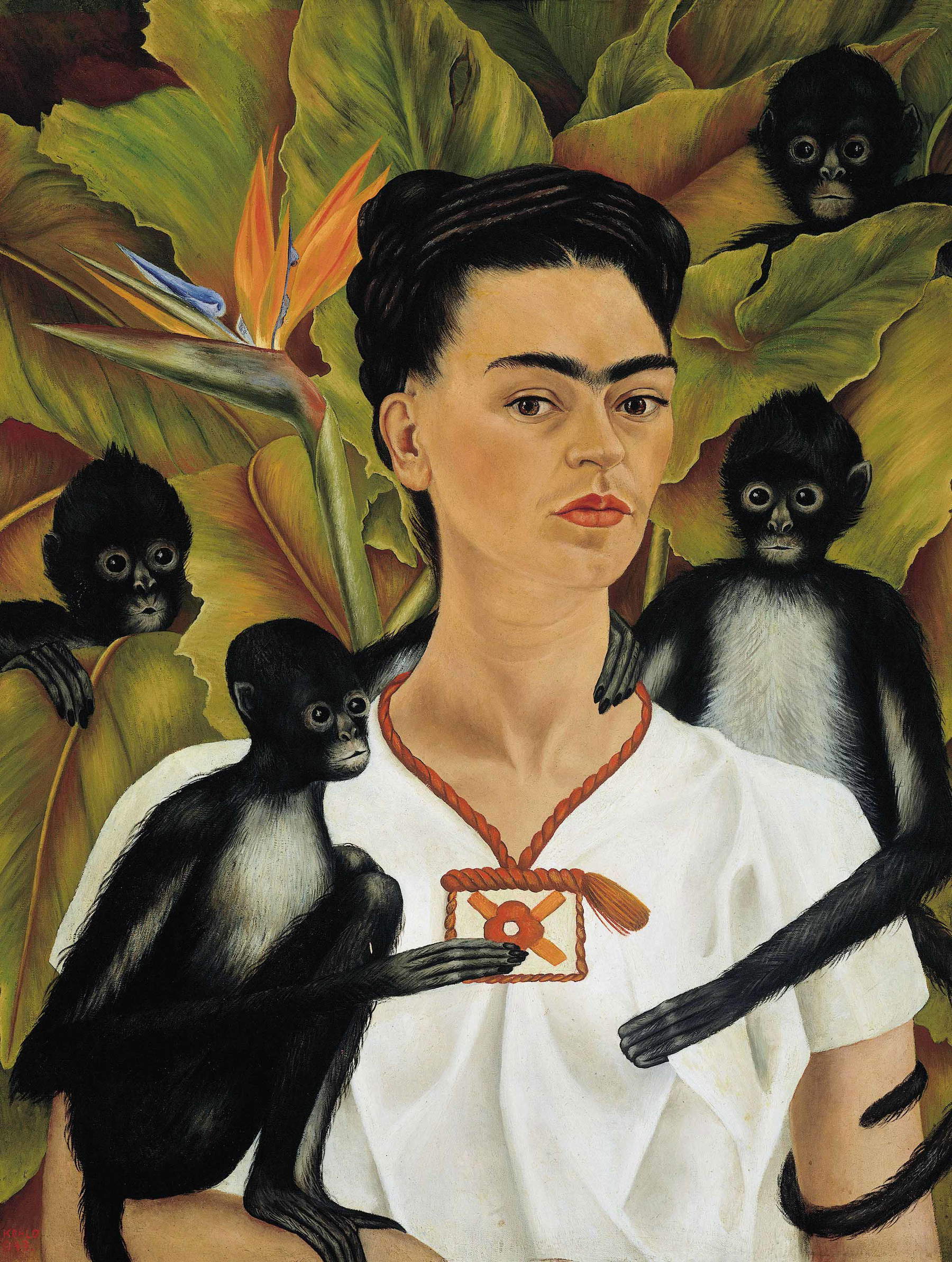 |
| Frida Kahlo, Self-Portrait with Monkeys (1943; oil on canvas, 81.5 x 63 cm; Mexico City, Jacques and Natasha Gelman Collection). © Banco de México Diego Rivera & Frida Kahlo Museums Trust |
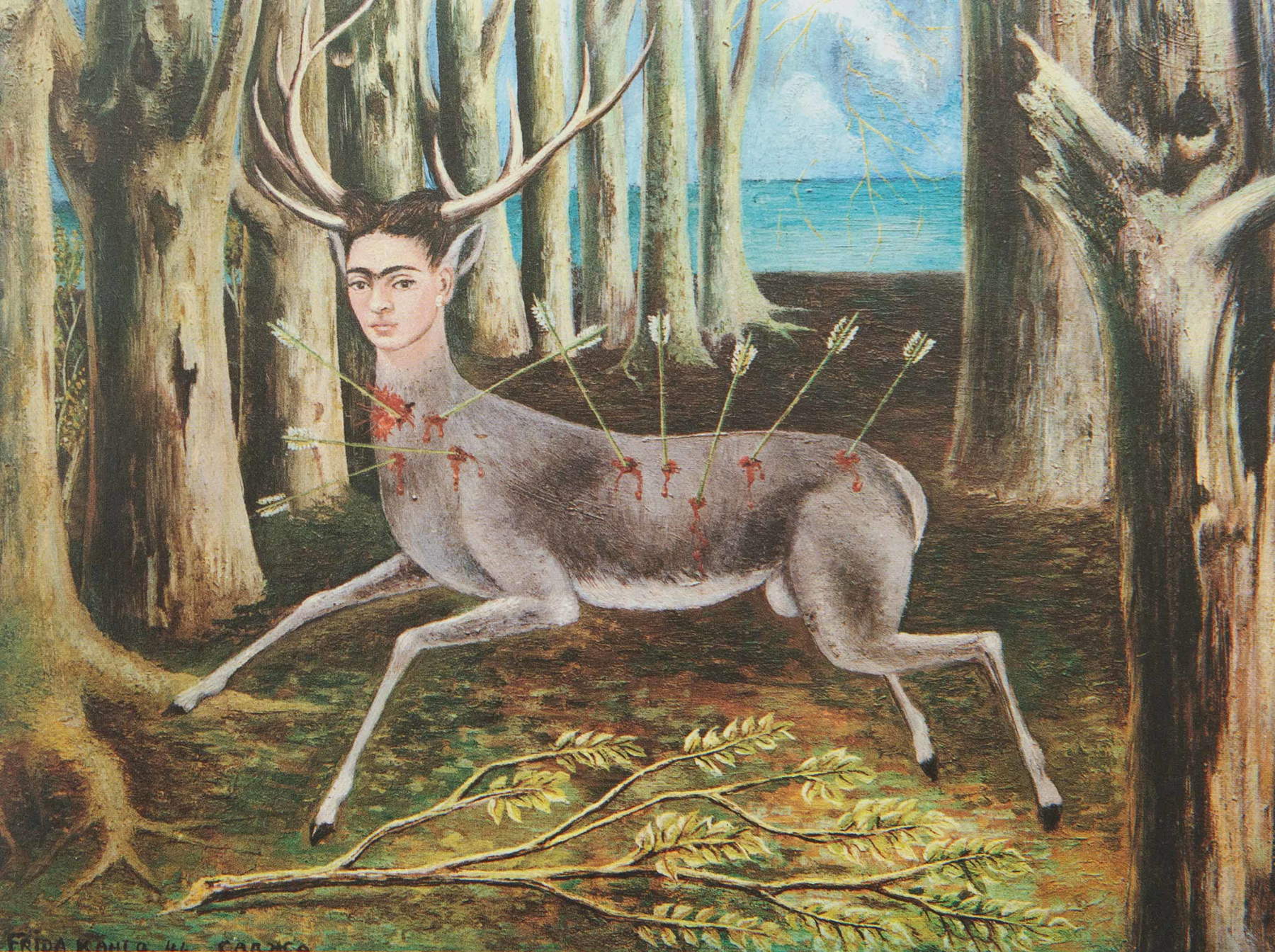 |
| Frida Kahlo, The Wounded Deer (1946; oil on masonite, 22.4 x 30 cm; Private Collection). © Banco de México Diego Rivera & Frida Kahlo Museums Trust |
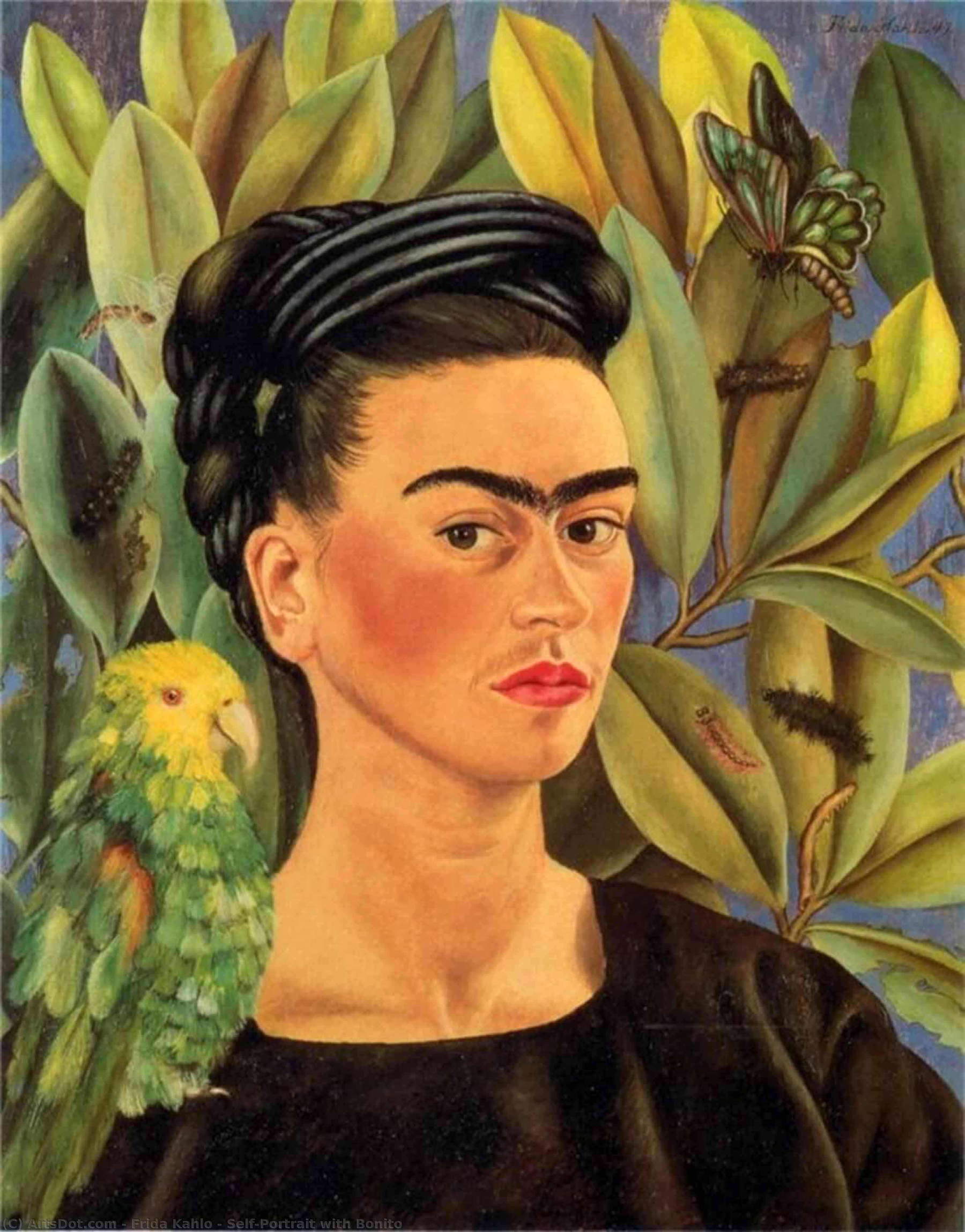 |
| Frida Kahlo, Self-Portrait with Bonito (1941; oil on canvas, 55 x 43.4 cm; Private collection). © Banco de México Diego Rivera & Frida Kahlo Museums Trust |
 |
| Frida Kahlo, The Broken Column (1944; oil on canvas pasted on masonite, 30.5 x 40 cm; Mexico City, Museo Dolores Olmedo). © Banco de México Diego Rivera & Frida Kahlo Museums Trust |
For her part, as part of her application, Frida wrote, stating her professional background: “I began painting twelve years ago, while I was recovering from an automobile accident that confined me to bed for almost a year. During all these years I worked with the spontaneous impulse of my feelings. I never followed any school or any influence, nor did I ever expect to derive more from my work than the satisfaction of pure and simple painting and saying what I could not have said in any other way.” She then added, “I have done portraits, figure compositions, even subjects in which landscape and still life are of great importance. I was able to find, without being forced by any prejudice, a personal form of expression through painting. For ten years my work consisted of eliminating everything that did not come from the inner lyrical motivations that drove me to paint.”
This was then followed by the statement initially quoted, in which she said that she “objectified all this into images of myself”: nothing but the explicit reason for her many self-portraits, the works in which Frida put on canvas all the inner chaos and existential travail she experienced throughout her life.
That funding was finally not granted to her.
In her Self-Portraits , she often depicted herself with her head erect in an almost haughty attitude, often in a half-length pose, and with a special attention to color and detail. She even made explicit in a writing the meaning she ascribed to different colors: although she recalled the traditional tones of Mexican art, mostly earthy, she gave each color a psychological value, from olive green to brown, yellow, blue and magenta. For example, olive green was often juxtaposed with the feeling of oppression, the color of scorched earth expressed despair and hopelessness, yellow madness and fear, and red and pink blood and death.
She is then often depicted with backgrounds of creepers, plants, of intricate tropical vegetation, sometimes with shoots. Monkeys keep her company many times, embracing her and becoming more frequent since her divorce with Rivera, beginning in 1940: it seems that the presence of the monkeys fills the void left by her husband, emphasizing her sense of loneliness. The 1940Self-Portrait with Thorn Necklace and Hummingbird also features a black cat in a threatening pose, while a dead hummingbird hangs from the necklace of thorns: the latter may cause her further injury, and the hummingbird (which is used in Mexico as a good luck charm in love) seems to refer back to herself, as she feels like that dead bird. In The Broken Column she has depicted herself as a martyr against the backdrop of a scorched earth. Often the braids of her hair are twisted around her neck, causing the viewer to feel suffocated.
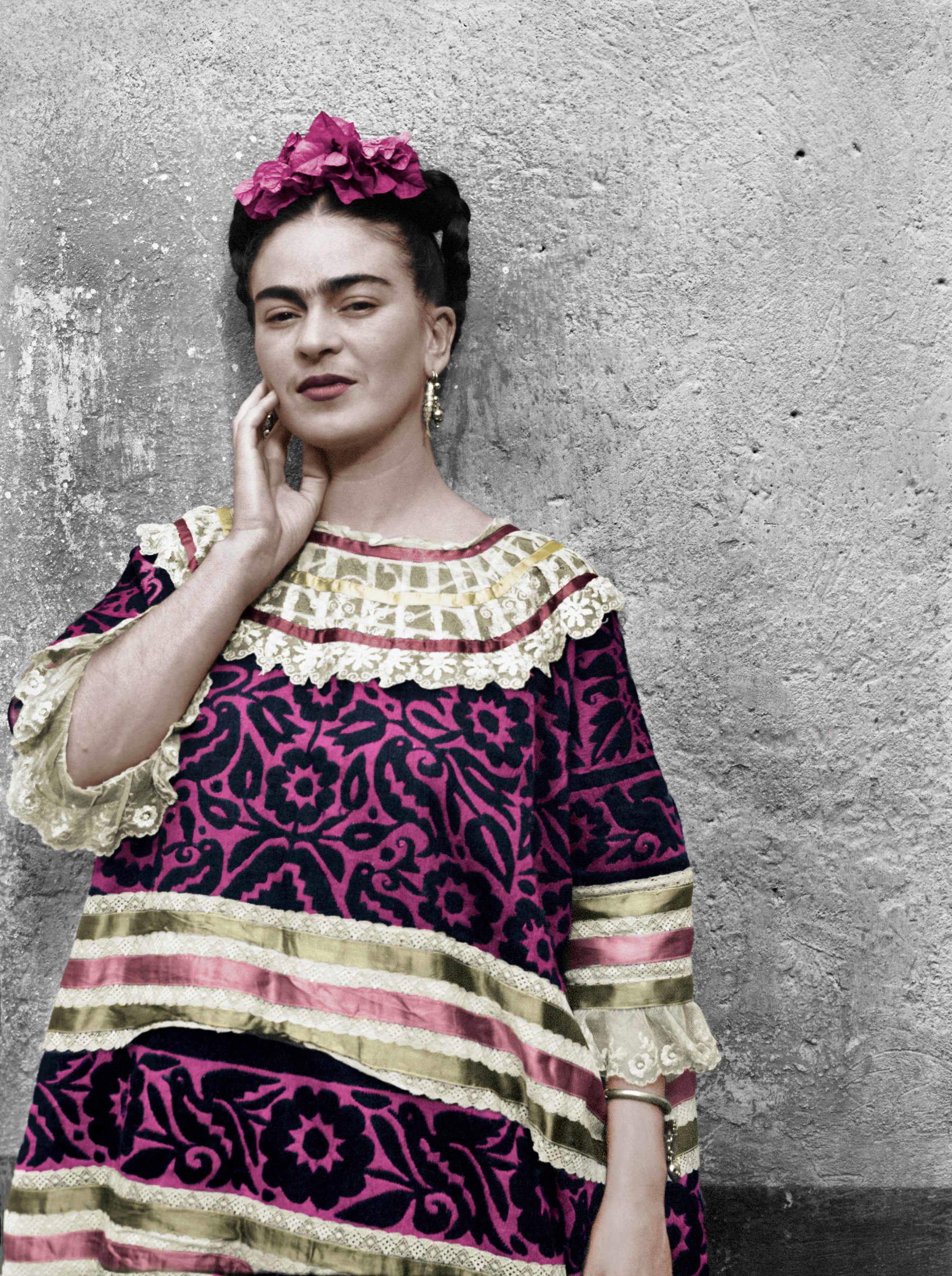 |
| Leo Matiz, Frida Kahlo (Coyacán, 1944; color photograph). © Leo Matiz Foundation |
 |
| Leo Matiz, Frida Kahlo in front of Casa Azul (Coyacán, 1944; color photograph). © Leo Matiz Foundation |
 |
| Leo Matiz, Frida Kahlo (Xochilmico, 1941; black and white photograph). © Leo Matiz Foundation |
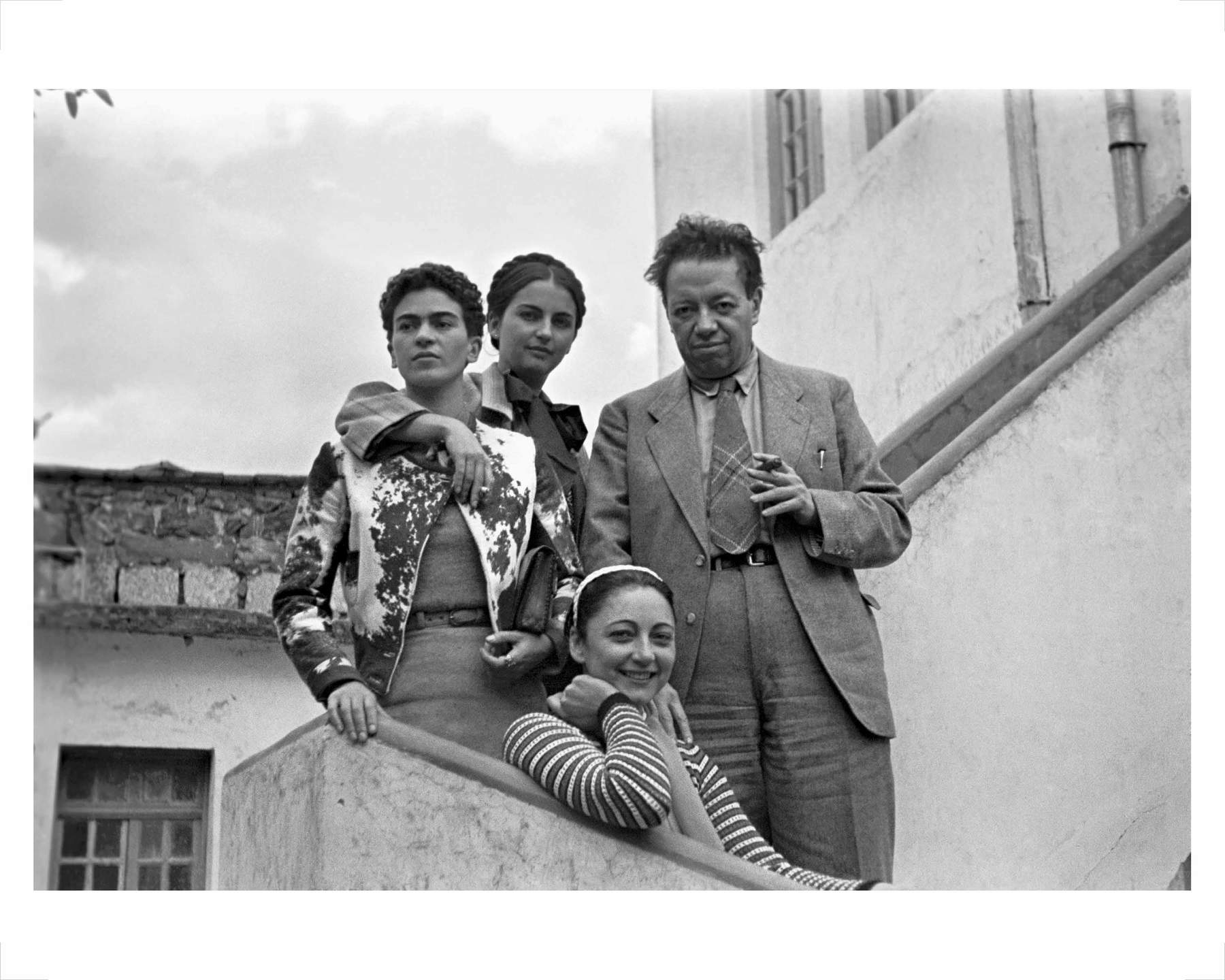 |
| Leo Matiz, Frida, Christina Kahlo, Diego Rivera and a friend (Mexico City, c. 1941; black and white photograph). © Leo Matiz Foundation |
Particularly significant is the depiction of Frida’s face in place of the snout of a wounded deer shot by many arrows, from whose wounds blood flows. Each of these self-portraits thus underscores the inner pain felt by Kahlo, in a juxtaposition between the face that seems to let no feeling shine through and everything else rich instead in symbols of that pain.
From the 1940s, Colombian photographer Leonet Matiz Espinoza made photographic portraits of the artist and friend that became iconic images of Frida. He immortalized her in the spaces of the woman’s everyday life , namely in the garden, studio, and interiors of the famous Casa Azul, at a time when the latter had achieved fame as a painter and as a woman had achieved independence both economically and emotionally. Matiz’s photographs thus portray a Frida who is different from the previously mentioned Self-Portraits in that she is proud and independent.
All the works discussed in this article can be seen from October 12, 2020 to March 29, 2021 at the Fabbrica del Vapore in Milan, where the exhibition Frida Kahlo. The Chaos Within, curated by Antonio Arèvalo, Alejandra Matiz, Milagros Ancheita and Maria Rosso. On display, in addition to the reproduced paintings, are reconstructions of the environments in which the artist lived and worked. For more information you can visit the exhibition website.
Warning: the translation into English of the original Italian article was created using automatic tools. We undertake to review all articles, but we do not guarantee the total absence of inaccuracies in the translation due to the program. You can find the original by clicking on the ITA button. If you find any mistake,please contact us.